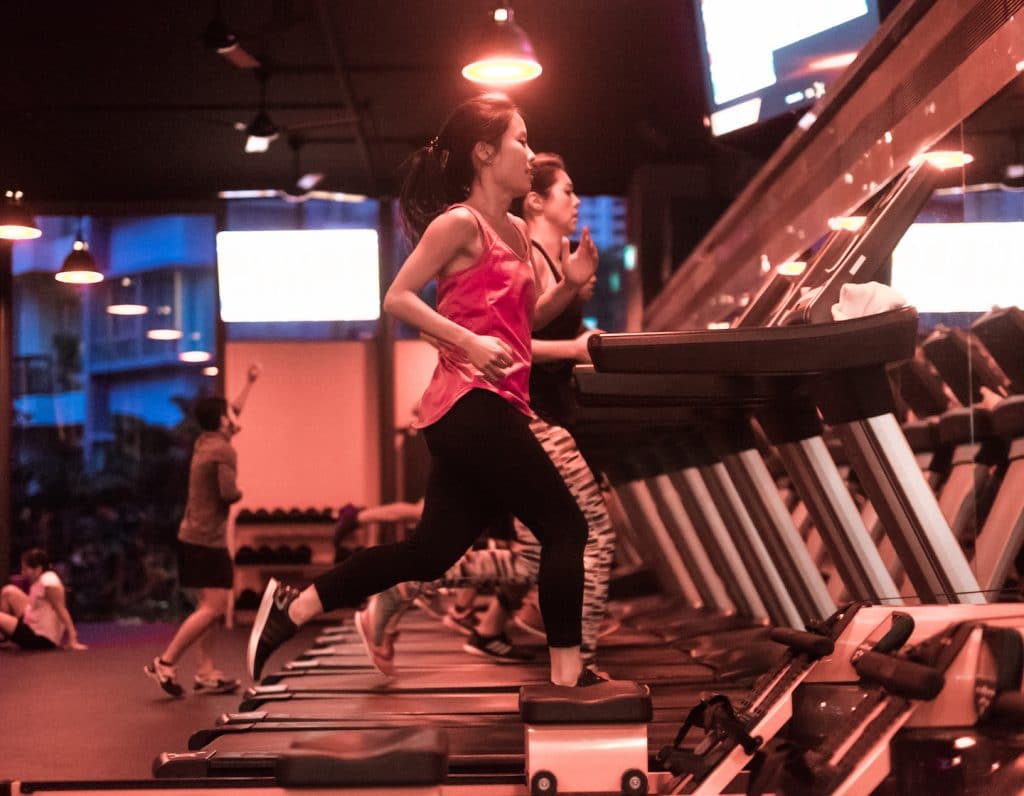
OrangeTheory Fitness is the exercise trend that’s sweeping the globe. Here’s what to expect from this tough but rewarding workout (plus a discount just for Sassy Mamas!)
I’m always up for trying out the newest exercise and fitness trends in Singapore, so I was basically…well…orange with envy when OrangeTheory Fitness opened in Singapore last fall and I couldn’t immediately try it out since I was nine months pregnant and then subsequently attached to a newborn.

Founded in the United States in 2010, OrangeTheory has exploded in popularity: there are now nearly 1,000 studios all over the world, and legions of devotees who swear by its addictive workouts and stellar results.
Curious to see how it differed from other popular HIIT classes in Singapore like Ritual and F45, once I finally got my act together I scheduled a free trial class at the Robertson Quay studio (there’s also a location in Tanjong Pagar, catering more to a CBD crowd).
Read More: How to Work Out with Kayla Itsines at FitnessFest 2018

Getting into the Orange Zone
With the tagline “Backed by Science”, OrangeTheory differs from other HIIT fitness classes with its emphasis on “Excess Post-Exercise Oxygen Consumption (EPOC)”. At OrangeTheory, there are five color-coded cardio zones that represent different levels of exertion. The orange zone, from which OrangeTheory draws its name, represents 84-91% of your maximum heart rate.
OrangeTheory workouts are all about keeping you in that orange zone for as long as possible, because it’s the ideal zone to stimulate metabolism, boost energy, and burn calories for up to 36 hours post-workout. Because everyone has different fitness levels and thresholds, and to keep you honest, OrangeTheory requires everyone to wear a specific heart-rate monitor (available to rent for $15 per session, or to purchase for $118).
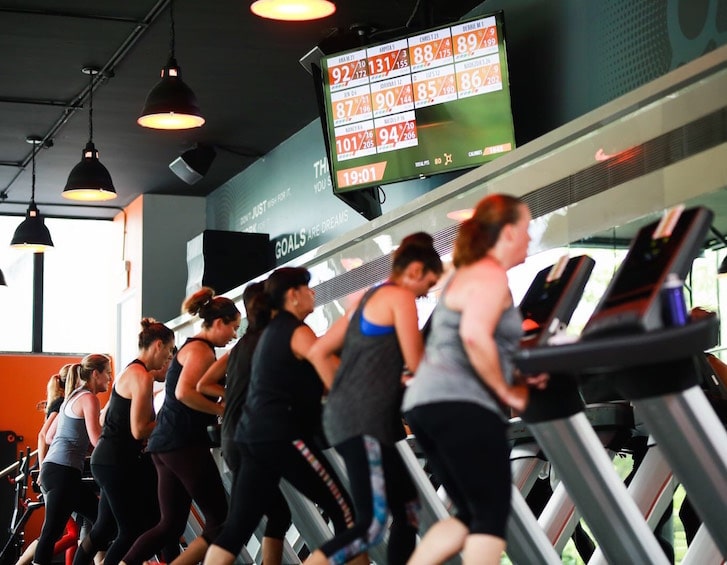
Everyone in the class’s percentage is displayed on a big board throughout the class. I liked this, not only because I was able to see my own exertion in realtime, but also because I’m extremely competitive, and if I saw that I was only in the green zone but someone else was in the orange, I immediately started pushing myself harder.
I also liked how everyone’s overall stats were displayed at the end of the class; the goal is to spend between 12-20 minutes of the 60-minute class in the orange or red zones to achieve optimal caloric burn; each minute earns you a “splat point”, which you’re encouraged to visualize as a fat cell exploding.
Read More: SG Fitness Trainers’ Fave Moves & Exercises

The Workouts
OrangeTheory has three types of workouts: power, endurance, and strength. Every workout lasts 60 minutes (including warm-up), and is overseen by an expert coach, who walks you through the exercises at the beginning and roams around throughout the class checking your form and barking out encouragement.
Each workout involves a combination of cardio on treadmills and rowing machines, and various strength and bodyweight exercises with equipment like weights, medicine balls, TRX suspension trainers, and more. It is a true total body workout.
Read More: Kayla Itsines, F45 & Ritual: Which HIIT Workout is Right For You?

You never know which workout will be featured on any particular day (the idea is that changing up the workouts will keep your body on its toes, so to speak, plus they don’t want you to play favorites and only attend one kind of workout). The sequence is random and, like F45, actually pre-programmed from a central location.
Also like F45, there is a screen that demonstrates some of the body-weight exercises. During the class I attended, we did things like mountain climbers, kettle bell swings, and jump squats. Halfway through, we switched to the cardio stations, and spent five minute intervals on a treadmill, where the coach, Reehana, talked us through about three minutes at a steady jog followed by one minute of a hard almost-sprint (I was dying after these!).
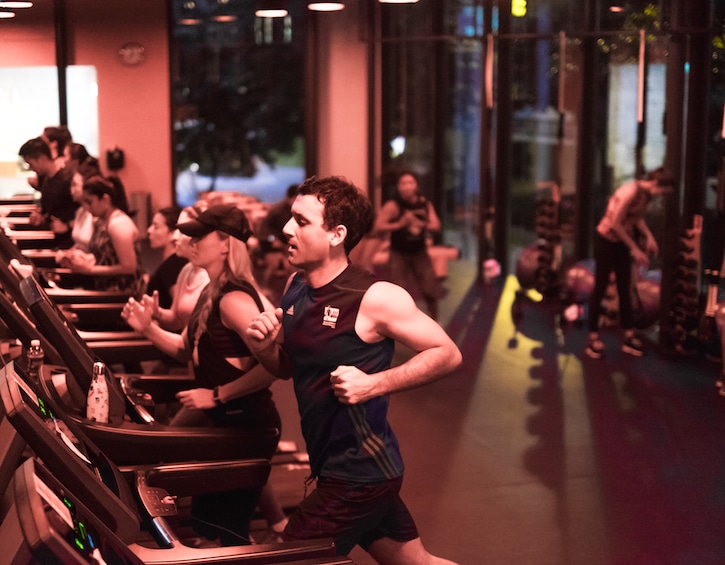
I really appreciated the loud music that was playing throughout the workout; at the start it was current pop hits (meh), but I felt fortunate that it segued to 90s alternative (like Nirvana and Pearl Jam) when I hit the treadmill (yes, I am an old lady).
Again, one of the coolest things about OrangeTheory is that you’re very much competing against yourself. On the treadmill, there are speed guidelines for whether you want to power walk, jog, or run (in other words, go at your own speed and with whatever you’re comfortable doing). We did three rowing intervals, and after each one were encouraged to write our distance on the board, with the goal of going further each time (had I known about this beforehand I might have held back a little during the first interval!).
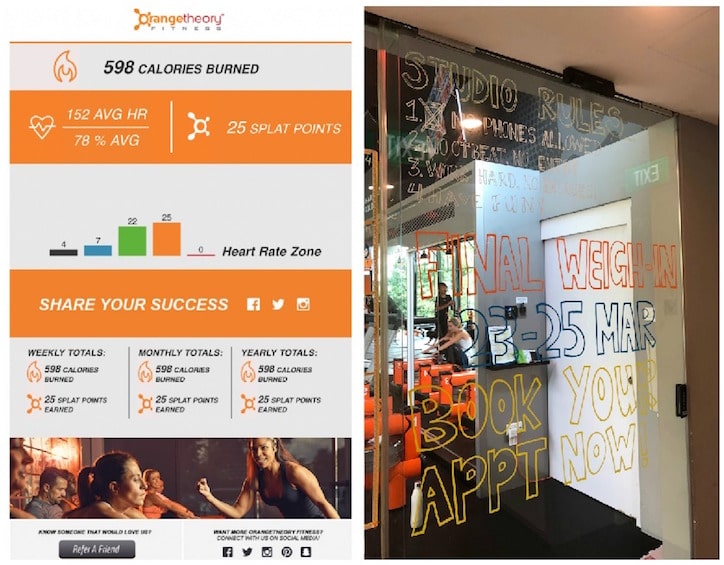
Once again, your aim is to spend as much of the workout in the orange or red (92-100% cardio capacity) zones as possible. At the end of class everyone’s stats are displayed on the board, and your own detailed stats are automatically emailed to you (you can also check them on an app). I have to admit, I held my head up a little bit higher for the rest of the day because I was proud to have spent 25 minutes in the orange zone.
Overall, it was a great – albeit really tough – workout. Reehana pushed us much harder than I would ever push myself. I’m in pretty good shape but came away exhausted, yet also on an endorphin high. In an ideal world I think it would be great to attend OrangeTheory classes two to three times a week…
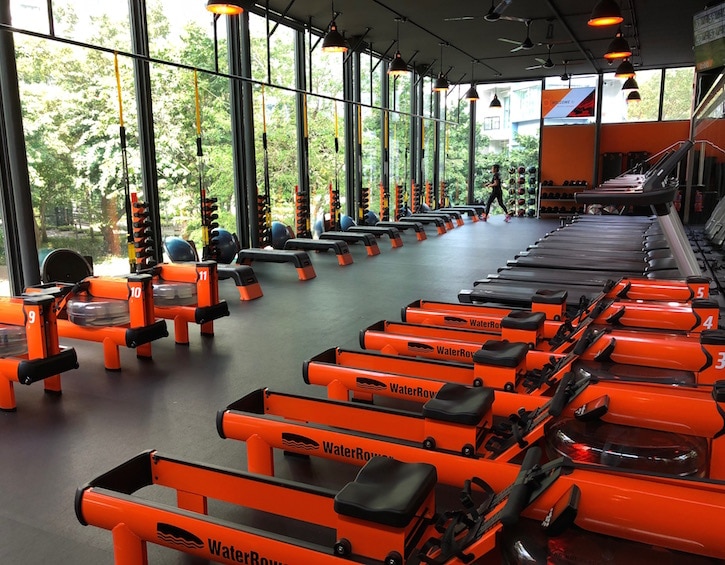
The Drawbacks
First and foremost, OrangeTheory is kind of pricey. You can pay $48 per session on a drop-in basis, or lower the per-class price a bit by opting for various multi-class packages or monthly memberships (ranging from four classes per month to unlimited session for the particuarly masochistic). There’s also the cost of the heart rate monitor (probably worth purchasing for $118 so long as you attend more than a few sessions).
At 60 minutes, workouts are not only tough, but long (in comparison, F45 is 45 minutes, and Ritual is just 20). The results speak for themselves, and I felt like I was on an endorphin high afterwards, but it is more of a commitment than some other gym classes. At the same time, I liked that there were fewer exercises than in F45 (which can often involve 20+ different moves/stations), but more extensive cardio than what you would do at Ritual. As a runner, OrangeTheory was probably the HIIT class that I’ve enjoyed most due to the treadmill component.
For right now classes are only offered in two locations (though I wouldn’t be surprised to see more studios open up soon), but there seem to be enough classes available throughout the day (with 24 slots available per session) that availability isn’t too scarce.

The Final Verdict
Would I go back to OrangeTheory again? Absolutely. Despite the high cost, I could see myself splashing out for a drop-in session every now and then when I want a really intense workout (after my next Wolfgang’s dinner, for instance). I loved the positive, communal vibe: both the session I attended and the class before included both men and women, and people of different ages and varying fitness abilities.
I was also really impressed by the coach, Reehana, who was super positive and energetic, and expertly kept 24 people motivated and working hard throughout the class. Add on the high-quality equipment and finely calibrated workouts, and you can begin to understand the cost.
Not only does OrangeTheory offer a free trial class so you can see if you like it, but they’re also offering a special discount for Sassy Mamas who decide to join. So really, what do you have to lose, mamas (other than lots of those pesky fat cells that will go splat!)?
![]() Quote SassyMama and receive 20% off the first month of a Premier (unlimited) membership.
Quote SassyMama and receive 20% off the first month of a Premier (unlimited) membership.
OrangeTheory Fitness Robertson Quay, 38A Martin Road, #02-01, Singapore 239059, Tel: (+65) 6266 1715, www.robertson-quay.orangetheoryfitness.com
OrangeTheory Fitness Tanjong Pagar, 2 Gopeng Street #01-58, Icon Village, Singapore 078877, Tel: (+65) 6224 4288, www.tanjong-pagar.orangetheoryfitness.com






 View All
View All




 View All
View All










 View All
View All







![[𝗡𝗘𝗪] 𝗣𝗮𝘀𝗶𝗿 𝗥𝗶𝘀’ 𝗕𝗿𝗼𝗻𝘁𝗼𝘀𝗮𝘂𝗿 𝗣𝗮𝗿𝗸 𝗶𝘀 𝗕𝗔𝗖𝗞. 𝗦𝗮𝗳𝗲𝗿 & 𝗙𝗨𝗟𝗟 𝗼𝗳 𝗗𝗶𝗻𝗼-𝗦𝗶𝘇𝗲𝗱 𝗙𝘂𝗻! 🦕🦖
A dinosaur you can climb into, a tail slide you can zoom down, and plenty of spots for kids to swing, bounce, and explore? Yeap, it’s a full-on dino adventure. After being closed for a major revamp, Brontosaur Park is now officially open (and safe!) for little adventurers to run wild.
Comment “DINO” or hit the link in bio for more epic outdoor playgrounds in Singapore!
𝗪𝗵𝗮𝘁 𝘄𝗲 𝗹𝗼𝘃𝗲:
- A Brontosaurus structure kids can explore from the legs to the belly
- A roller slide that goes right down the dino’s tail
- Rope bridges, climbing nets & hammocks between stego spikes = plenty of ways to burn off energy
- Toddler-friendly mini dino zone for the little ones
- Spot dino sculptures painted by residents (hidden all around the park)
𝗧𝗶𝗽𝘀 𝗳𝗼𝗿 𝗺𝗮𝘅 𝗳𝘂𝗻:
- Wear grippy shoes. Lots of climbing involved
- Pack snacks and water (There are minimarts nearby)
𝗪𝗵𝗲𝗿𝗲? The playground is located between Blk 777 & 778, along Pasir Ris St 71
𝗖𝗼𝘀𝘁? FREE!
.
.
.
.
.
#DinoPlaygroundSG #PasirRisPlayground #SgPlaygrounds #OutdoorFunSG #FreePlaygroundsSG #BrontosaurPark #SgFamilyAdventures #ThingsToDoWithKidsSG #SingaporeWithKids #PlaygroundGoalsSG #ToddlerPlaySG](https://www.sassymamasg.com/wp-content/plugins/instagram-feed/img/placeholder.png)
